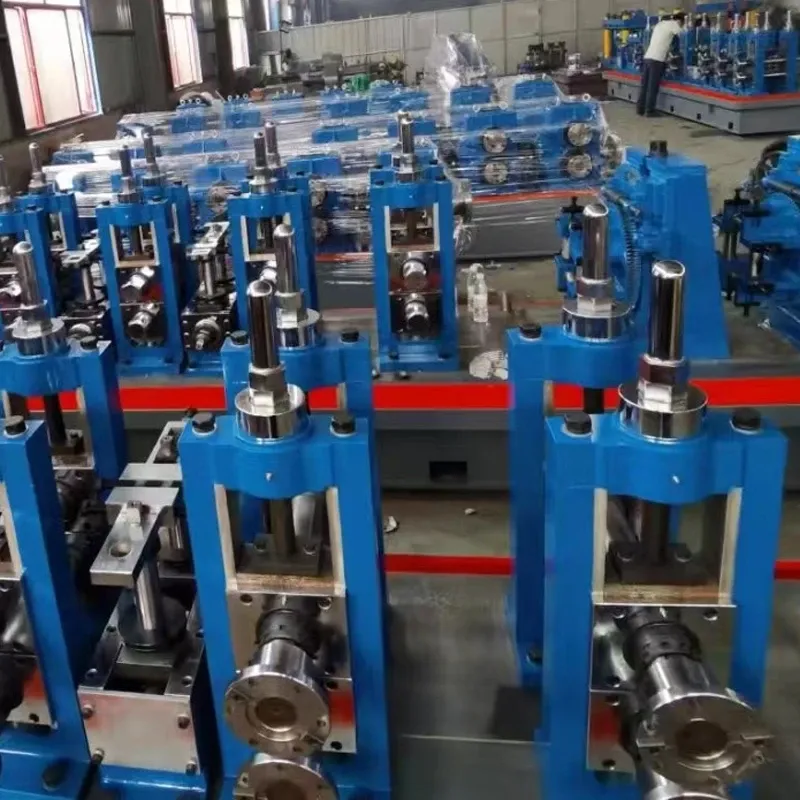Automation and Efficiency in Welded Pipe Production Line Design
The evolution of welded pipe manufacturing has been driven by advancements in automation, material science, and process optimization. Technologies such as tub i salduar me frekuencë të lartë, high frequency welded tube, dhe seamless erw pipe production systems now prioritize speed, precision, and sustainability. This article examines how modern production lines integrate automation to enhance efficiency, reduce waste, and meet diverse industrial demands, while addressing common questions about these systems.

High Frequency Welded Pipe: Speed and Consistency in Manufacturing
Të tub i salduar me frekuencë të lartë process is a cornerstone of modern pipe production, leveraging electromagnetic induction to create robust seams at unparalleled speeds. Automated systems feed steel coils through forming rolls, shaping them into cylindrical profiles before applying high-frequency currents to fuse the edges. This method excels with carbon steel and stainless steel, producing pipes for plumbing, automotive exhausts, and structural frameworks.
Automation ensures consistent weld quality by adjusting power input based on material thickness and alloy composition. For example, dual-loop control systems monitor seam temperature in real time, preventing defects like cold welds or oxidation. In HVAC applications, these pipes are coated with zinc or polymer layers post-welding, automated spray systems ensuring uniform coverage to resist corrosion. Advanced lines also incorporate AI-driven defect detection, using cameras and ultrasonic sensors to flag imperfections before pipes proceed to cutting or coiling stages.
High Frequency Welded Tube: Precision for Specialized Applications
While similar to pipes, high frequency welded tube production demands tighter tolerances for applications like hydraulic systems or precision instrumentation. Tubes made from aluminum or copper alloys require finer control over wall thickness and ovality. Automated mandrel systems inside the forming rolls maintain circularity during high-speed welding, critical for medical gas delivery systems where leaks are intolerable.
Laser measurement tools integrated into production lines validate dimensions within ±0.05 mm, adjusting roll pressures dynamically. For refrigeration tubes, post-weld annealing processes restore ductility to copper-nickel alloys, all managed by programmable logic controllers (PLCs). These systems also optimize material usage, nesting tube lengths to minimize scrap—particularly vital for expensive materials like titanium used in aerospace.
Seamless ERW Pipe: Merging Traditional and Modern Techniques
The term seamless erw pipe may seem contradictory, as ERW (Electric Resistance Welding) inherently creates a seam. However, advancements in cold-forming and heat treatment now produce ERW pipes with seamless-like properties. By combining automated rotary forging with inline normalization, manufacturers achieve grain structures comparable to seamless pipes, ideal for high-pressure oil and gas transmission.
These lines process low-alloy steels and duplex stainless steels, materials favored for their strength-to-weight ratios. Automated eddy current testing (ECT) systems scan each pipe, identifying subsurface flaws that could compromise integrity in subsea environments. Post-weld, robotic polishing arms smooth inner surfaces, reducing friction losses in fluid transport—a key efficiency gain for petrochemical industries.
Welded and Seamless Pipe: Strategic Selection for Industrial Needs
The debate between welded and seamless pipe hinges on application-specific requirements. Automated welded lines dominate high-volume sectors like construction, where cost efficiency and moderate pressure ratings suffice. Carbon steel welded pipes, for instance, form skeletal frameworks in skyscrapers, with robotic plasma cutters tailoring lengths onsite.
Seamless pipes, produced via extrusion or piercing, remain irreplaceable for ultra-high-pressure scenarios, such as steam lines in power plants. Yet, hybrid systems now exist: automated ERW lines feed into seamless finishing processes, merging the economies of welding with the performance of seamless products. Material choice further guides this balance—nickel alloys for corrosion resistance often start as welded pipes before seamless machining for nuclear reactor components.
FAQS:About Welded and Seamless Pipe
How does automation reduce defects in high frequency welded pipe manufacturing?
Automated tub i salduar me frekuencë të lartë systems use closed-loop feedback to adjust welding parameters in real time. Infrared sensors detect temperature anomalies, while AI classifiers analyze ultrasonic data to halt production if flaws exceed thresholds.
What materials challenge high frequency welded tube production?
Reflective metals like aluminum initially posed issues for high frequency welded tube systems due to energy dissipation. Modern solutions include pre-heating coils and optimized frequency settings to ensure consistent weld penetration.
Can seamless erw pipe withstand corrosive environments?
Yes, seamless erw pipe made from duplex stainless steel resists pitting and stress corrosion cracking. Automated passivation baths apply nitric acid to enhance chromium oxide layers post-welding.
When is welded and seamless pipe hybridization advantageous?
Hybrid welded and seamless pipe systems benefit industries needing cost-effective bulk production with localized seamless performance, such as shipbuilding, where welded hull pipes interface with seamless engine components.
Why choose ERW for welded erw pipe in structural projects?
Welded erw pipe offers superior dimensional consistency versus seamless alternatives, crucial for prefabricated steel structures. Automated ERW lines also deliver faster turnaround times for large-scale infrastructure projects.
From high frequency welded pipes to hybrid welded and seamless pipe solutions, automation has redefined efficiency and quality in production lines. By aligning material properties with robotic precision, manufacturers meet evolving industrial demands while reducing environmental footprints. As AI and IoT technologies mature, the next frontier lies in self-optimizing systems that adapt to raw material variability in real time—ushering in a new era of smart pipe manufacturing.
-
Revolutionizing Pipe Production with Modern MachineryLajmeJun.04,2025
-
Precision in Plastic Injection MoldersLajmeJun.04,2025
-
Precision Cutting with Flying Shear TechnologyLajmeJun.04,2025
-
Portable Metal Roof Roll Forming: Revolutionizing On-Site FabricationLajmeJun.04,2025
-
Mastering Pipe Cutting Laser in Modern FabricationLajmeJun.04,2025
-
Innovations in Welded Gas Pipe TechnologyLajmeJun.04,2025


